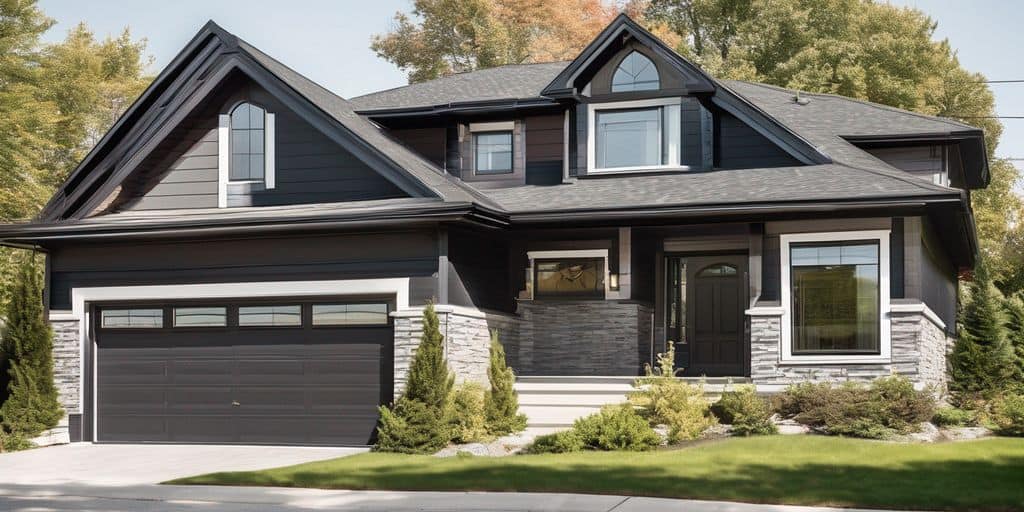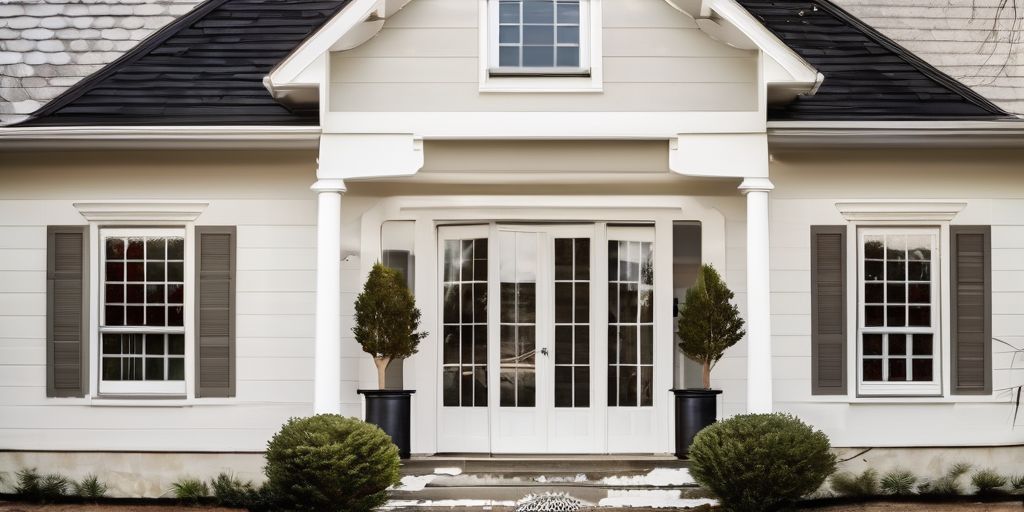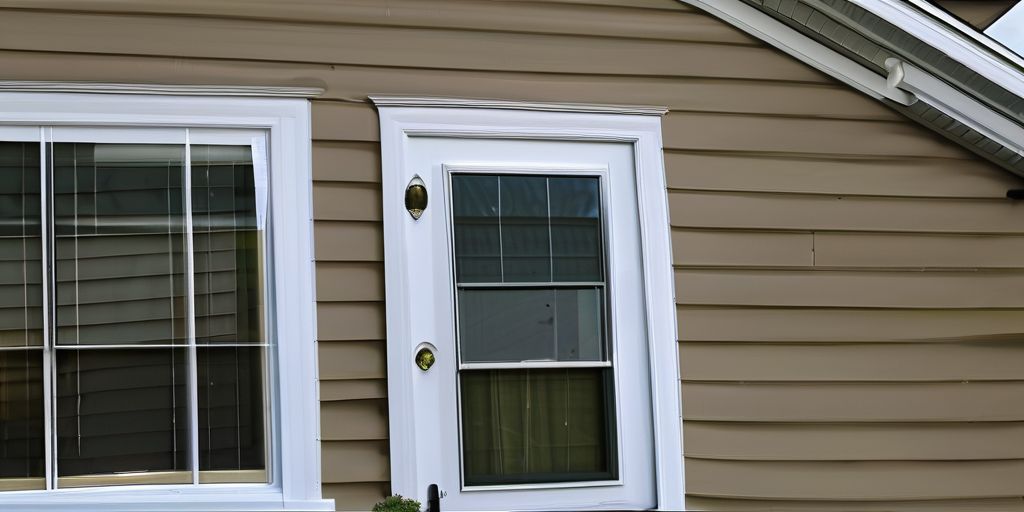Dark vinyl siding can make homes look stylish and modern, but keeping its color from fading can be tricky. In Mississauga, the weather and other factors can speed up color fading. This article will help you understand why color fades and how to keep your siding looking great for longer.
Key Takeaways
- Choose light colors or shades no darker than the original to reduce fading.
- Properly prepare the surface before painting to ensure the best results.
- Apply extra coats for darker shades to achieve full coverage.
- Monitor weather conditions during painting to ensure proper drying and adhesion.
Understanding the Causes of Color Fading
Impact of UV Rays
One of the main reasons for color fading in vinyl siding is exposure to UV rays. These rays break down the chemical bonds in the paint, causing it to lose its original color. Prolonged exposure to sunlight can lead to significant fading, especially on surfaces with southern exposure. To minimize this, consider harmonizing colors for vinyl siding and trim, which can help with UV protection and curb appeal.
Role of Weather Conditions
Weather conditions also play a crucial role in color fading. Rain, snow, and wind can wear down the paint over time. In areas like Mississauga, where seasonal changes are common, the siding is exposed to a variety of weather conditions that can accelerate fading. Temperature fluctuations and humidity levels can also contribute to the problem.
Effect of Poor Maintenance
Poor maintenance can exacerbate color fading. Regular cleaning and inspections are essential to keep the siding in good condition. Ignoring these tasks can lead to issues like mold growth, which can further damage the paint. It’s important to address common challenges like fading and warping by choosing low-maintenance colors inspired by local homes.
Regular maintenance not only prolongs the life of your siding but also keeps it looking vibrant and new.
Choosing the Right Paint for Vinyl Siding
When it comes to painting vinyl siding, selecting the right paint is crucial for a long-lasting and vibrant finish. Here are some key considerations to keep in mind.
Importance of Light Colors
Opting for light colors such as white, off-whites, and pastels can significantly reduce the risk of color fading. Light colors reflect more sunlight, which helps in maintaining the vibrancy of the paint for a longer period. Additionally, lighter shades are less likely to absorb heat, reducing the stress on the vinyl material.
Additional Coats for Darker Shades
If you prefer darker shades, it’s important to apply additional coats of paint. Dark colors tend to absorb more heat, which can cause the vinyl to warp or fade more quickly. By applying extra layers, you can enhance the paint’s durability and longevity.
An exterior painter can provide valuable insights on the best paint choices and application techniques to ensure a long-lasting finish.
Whether you’re harmonizing vinyl siding and trim colors or simply refreshing your home’s exterior, choosing the right paint and color can make a significant difference.
Proper Application Techniques
Surface Preparation
Before you start painting, it’s crucial to prepare the surface properly. Remove any dirt, grease, or old flaking paint before applying a new coat. Ensure the surface is clean, dry, and free of peeling paint or mildew. You should also repair any damaged areas to enhance the longevity and aesthetic appeal of the painted siding.
Painting in Optimal Weather
Weather conditions play a significant role in the success of your painting project. Aim to paint on a dry day with moderate temperatures. Extreme heat or cold can affect the paint’s performance. If you’re painting in Mississauga, keep an eye on the forecast to choose the best day for your project.
Ensuring Adequate Ventilation
Proper ventilation is essential when painting, especially for indoor projects. Make sure to open windows and doors to allow fresh air to circulate. This helps in drying the paint faster and reduces the inhalation of fumes. For outdoor projects, natural ventilation is usually sufficient, but it’s still important to be mindful of wind conditions.
Remember, a well-applied primer can significantly extend the life of your paint job, providing lasting beauty and protection for the siding.
Maintenance Tips to Prolong Color
Maintaining the vibrant color of your vinyl siding requires consistent effort. Here are some tips to help you keep your siding looking fresh and new for years to come.
Regular Cleaning
Cleaning it regularly and removing all dirt and debris can help to prolong its life. Use a mild detergent mixed with water and a soft brush to scrub the surface. Rinse thoroughly with a garden hose to remove any soap residue. Avoid using high-pressure washers as they can damage the siding.
Inspecting for Damage
Regularly inspect your siding for any signs of damage, such as cracks or loose panels. Addressing these issues promptly can prevent further deterioration and maintain the overall appearance of your home. If you live near a landmark like the Rattray Marsh Conservation Area, be mindful of the additional wear and tear from local wildlife.
Repainting Schedule
A consistent maintenance regimen preserves appearance and extends paint lifespan for enduring home beauty. Plan to repaint your vinyl siding every 5-10 years, depending on the quality of the paint and the environmental conditions. For darker shades, you might need to repaint more frequently to maintain the color’s vibrancy.
Consistent maintenance is key to preserving the beauty of your home. Regular cleaning, timely repairs, and a proper repainting schedule can make a significant difference in the longevity of your vinyl siding.
Climate Considerations in Mississauga
When painting vinyl siding in Mississauga, it’s crucial to consider the local climate. The weather here can significantly impact the durability and appearance of your paint job. Understanding these factors can help you achieve the best results.
Temperature Fluctuations
Mississauga experiences a wide range of temperatures throughout the year. These fluctuations can affect the adhesion and curing of paint. During the hot summers, the paint may dry too quickly, leading to cracks. In the cold winters, it might not cure properly, causing peeling. It’s essential to choose the right time of year for painting to avoid these issues.
Humidity Levels
High humidity can also impact your painting project. When the air is too moist, the paint may not adhere well to the vinyl siding. This can lead to bubbling and an uneven finish. To combat this, try to paint on days when the humidity is low. This will help ensure a smooth and durable finish.
Seasonal Changes
The changing seasons in Mississauga can pose challenges for maintaining your vinyl siding. Spring and fall are often the best times to paint, as the temperatures are moderate and the humidity levels are more manageable. However, always keep an eye on the weather forecast to avoid unexpected rain or extreme temperatures.
The iconic Mississauga Civic Centre stands as a testament to the importance of considering local climate when planning any exterior painting project. Its resilience against the local weather highlights the need for proper application and material choice.
Common Mistakes to Avoid
When painting vinyl siding, there are several common mistakes that can lead to less-than-ideal results. Avoiding these pitfalls can help ensure a professional-looking finish that lasts longer.
Skipping Surface Preparation
One of the biggest mistakes is not preparing the surface properly. This includes cleaning the siding thoroughly to remove dirt, mildew, and chalky residue. Skipping this step can result in poor paint adhesion and a shorter lifespan for your paint job.
Using Low-Quality Paint
Choosing the wrong type of paint can also be a costly error. Low-quality paints may not adhere well to vinyl and can fade or peel quickly. Always opt for high-quality, exterior-grade paint designed specifically for vinyl siding.
Ignoring Weather Conditions
Painting in the wrong weather conditions can ruin your project. Avoid painting on extremely hot or cold days, and steer clear of rainy or humid weather. Ideal conditions include mild temperatures and low humidity.
For those living in Mississauga, it’s crucial to consider local weather patterns, especially the temperature fluctuations and humidity levels.
Not Applying Even Coats
Applying uneven coats of paint can lead to streaks and an unprofessional appearance. Make sure to apply the paint evenly and consider using multiple coats for darker shades to achieve a uniform look.
Using the Wrong Tools
Using inappropriate tools can also affect the quality of your paint job. Invest in good-quality brushes and rollers designed for exterior use. This will help you achieve a smoother and more even finish.
By avoiding these common mistakes, you can ensure that your vinyl siding looks great and stands up to the elements for years to come.
When it comes to painting your home, there are some common mistakes you should avoid. One big mistake is not preparing the surface properly before painting. This can lead to peeling and a poor finish. Another mistake is choosing the wrong type of paint for the surface. To avoid these issues and get a professional finish, visit our website for more tips and expert advice.
Conclusion
In summary, keeping Mississauga’s dark vinyl siding looking fresh and vibrant is achievable with the right approach. By choosing lighter paint colors, such as whites and pastels, and using high-quality acrylic latex paint, homeowners can effectively reduce color fading. It’s also important to consider the local climate when planning your painting project, as weather conditions can impact drying times and overall results. With proper preparation, careful application, and attention to detail, you can ensure your home’s exterior remains beautiful and well-protected for years to come.
Frequently Asked Questions
Why does vinyl siding fade?
Vinyl siding fades mainly due to exposure to the sun’s UV rays. Weather conditions and poor maintenance can also speed up the fading process.
Can I use dark colors on my vinyl siding?
It’s best to use light colors like white, off-whites, or pastels. Dark colors may require extra coats and can fade faster.
How should I prepare the surface before painting?
Clean the siding thoroughly and make sure it’s dry. Remove any dirt, mold, or loose paint to ensure the new paint adheres well.
When is the best time to paint vinyl siding?
Paint during mild weather conditions. Avoid painting in extreme heat or cold, and make sure there’s no rain in the forecast.
How often should I repaint my vinyl siding?
Inspect your siding regularly for signs of wear. Typically, you should repaint every 5-10 years depending on the condition and local climate.





